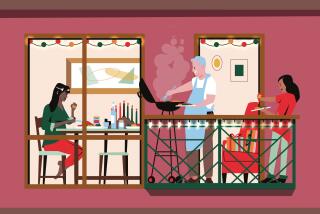Tilting Tables Popular Space-Savers
- Share via
The tilt-top table has been a popular piece since the 18th century. The top was made to tip so the table could be stored close to a wall. The round tilt-top table with a tripod base was a popular design in the 1740s. Most of the tables had a smooth, flat round top. The best examples had a raised rim or a dish top that kept spilled liquids and dishes from sliding to the floor. Copies of this useful style are still being made.
A rarer style, known as a supper table or wine-tasting table, had added carvings of plate-shaped indentations. Food or wine was served in dishes that were set in each indentation. The tables, with tops about 24 to 30 inches in diameter, were too small for eight seated diners, but the food could be served buffet-style.
In Victorian times, many plain round-topped tables were recarved with plate-shaped sections. These reworked tables are of little value today (about $500 to $1,500), while an 18th century piece in original condition is worth thousands of dollars.
*
Question: My dinnerware set has a mark on the bottom in the shape of an eagle, with the initials “NRA” over it. Can you tell me what the initials stand for? Could it be the National Rifle Assn.?
*
Answer: No. The letters stand for National Recovery Administration, a Depression-era U.S. government agency established by the National Industrial Recovery Act of 1933. The agency instituted industry codes that were meant to eliminate unfair trade practices, reduce unemployment, set minimum wages and maximum hours, and guarantee the right of collective bargaining.
Companies that agreed with the NRA codes could display the NRA Blue Eagle emblem, which is on your dishes. The NRA’s code system was found to be unconstitutional by the U.S. Supreme Court in 1935, so your dishes were made sometime between 1933 and 1935.
*
Q I thought home bread-baking machines were a recent invention, but my grandmother has a metal one that belonged to her mother. It is shaped like a bucket, and it has a flat top with a crank in the center. The crank moves the kneading rod inside. It is marked “No. 4 Universal Bread Maker, Made by Landers, Frary & Clark.” Can you tell me when it was made and if it’s worth anything as a collectible?
*
A Your great-grandmother’s Universal brand bread maker was first made in 1904. That same year, the machine won a gold medal at the St. Louis World’s Fair.
Landers, Frary & Clark was one of the most prestigious names in housewares until it closed in 1965.
Unlike today’s electric bread makers, the old Universal machine did not bake the bread, but it did provide a convenient way to mix ingredients and knead dough. Your old bread maker would sell for about $50.
*
Q I recently bought a Steiff stuffed monkey that’s in excellent condition. He has a hole in his left ear where I was told his “Button in Ear” tag was once attached. The monkey’s body tag, however, is still attached. It says “Jocko.” Can you tell me anything about the toy?
*
A Steiff (rhymes with “life”) is a German company that’s most famous for its stuffed teddy bears. But the company has made other stuffed dolls and animals, including monkeys, since its founding in 1877. Jocko, a stuffed chimpanzee, was introduced shortly before it was patented in 1925.
He was a big hit, especially in the United States, and has been made in various sizes and styles over the years. Steiff animals are labeled with a body tag and an ear tag held on with a button that reads, “Steiff.” Too bad the ear tag on your monkey is missing. The tag styles could help determine its age.
*
Q Can you tell me what my Coca-Cola advertising sign is worth? It is made in the shape of a policeman holding a sign that reads, “Slow, School Zone.” There is a Coca-Cola logo on the back and on the heavy, metal base. It is 4 1/2 feet tall. Unfortunately, my sign has a few BB holes in it.
*
A Coca-Cola made metal advertising signs shaped like yours during the 1950s and ‘60s. There were two styles. The 1950s sign has a circular logo on the back. The ‘60s sign has a fishtail logo. Unfortunately for collectors, kids often used the metal signs for target practice. A mint 1950s sign sells for as much as $1,800. A damaged sign is worth $500 or less.
*
Q I have a tiny strainer that is just a couple of inches in diameter. It is silver, with a decorative edge and handle. There is no maker’s mark on it. What is it for and what is it worth?
*
A You have a tea strainer. Brewed tea made with loose tea leaves was often served using a strainer so that the tea leaves did not get into the cups. Old, unmarked silver tea strainers sell for $50 to $75.
For a listing of helpful books and publications, include a self-addressed, stamped (55 cents) envelope to Kovels, Los Angeles Times, King Features Syndicate, 235 E. 45th St., New York, NY 10017.
Current Prices
Current prices are recorded from antiques shows, flea markets, sales and auctions throughout the U.S. Prices vary because of local economic conditions.
* Doorbell knob, glass, brass shank, tapered spindle with original threaded back plate, circa 1860s, 1 3/4 inches, $35.
* Bakelite Pluto pencil sharpener, figural, 1940s, $50.
* Brass bookends, Washington Crossing the Delaware, marked solid brass, “c” in circle, Jennette & Sons stamp, 1930, 6 inches, $95.
* Ceramic German shepherd string holder, Royal Trico, Japan, $175.
* “The Rise & Fall of the Confederate Government” book, by Jefferson Davis, 1881, New York, two volumes, $250.
* Love Nest Candy Bar sign, “Best Eating Candy Bar In The World,” 1930s, 10 by 28 inches, $300.
* Railroad conductor’s lantern, nickel-plated, kerosene font with clear etched shade, flowered wreath center, marked “G.A. Pierce,” by Adams & Westland, patent dated “64,” 10 1/2 inches, $460.
* Madame Alexander Wendy Bride doll, walker, sleep eyes, blond wig, tag, 1953, 18 inches, $475.
* Rookwood vase, winter landscape, 1919, marked, 10 inches, $3,220.
* Sewing box, stencil design, green border, silver and gold stars, red lines, smoke ground, sliding lid, brass pull, 1808, 5 by 9 by 6 inches, $5,200.
More to Read
Eat your way across L.A.
Get our weekly Tasting Notes newsletter for reviews, news and more.
You may occasionally receive promotional content from the Los Angeles Times.









